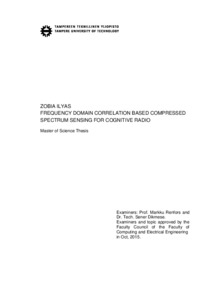Frequency Domain Autocorrelation Based Compressed Spectrum Sensing for Cognitive Radio
Ilyas, Zobia (2016)
Ilyas, Zobia
2016
Master's Degree Programme in Information Technology
Tieto- ja sähkötekniikan tiedekunta - Faculty of Computing and Electrical Engineering
This publication is copyrighted. You may download, display and print it for Your own personal use. Commercial use is prohibited.
Hyväksymispäivämäärä
2016-04-06
Julkaisun pysyvä osoite on
https://urn.fi/URN:NBN:fi:tty-201603233746
https://urn.fi/URN:NBN:fi:tty-201603233746
Tiivistelmä
As wireless applications are growing rapidly in the modern world, this results in the shortage of radio spectrum due to the fixed allocation of spectrum by governmental agencies for different wireless technologies. This problem raises interest to utilize spectrum in a more efficient way, in order to provide spectrum access to other users when they need it. In wireless communications systems, cognitive radio (CR) is getting much attention due to its capability to combat with this scarcity problem. A CR senses the available spectrum band to check the activity of primary users (PU). It utilizes the unused spectral resources by providing access to secondary users (SU). Spectrum sensing (SS) is one of the most critical issues in cognitive radio, and there are various SS methods for the detection of PU signals. An energy detector (ED) based SS is the most common sensing method due to its simple implementation and low computational complexity. This method works well in ideal scenarios but its detection performance for PU signal degrades drastically under low SNR values in the presence of noise uncertainty. Eigenvalue-based SS method performs well with such real-life issues, but it has very high computational complexity. This raises a demand for such a detector which has less computational complexity and can perform well in practical wireless multipath channels as well as under noise uncertainty.
This study focuses on a novel variant of autocorrelation detector operating in the frequency domain (FD-AC). The method is applicable to PUs using the OFDM waveform with the cyclic prefix (CP). The FD-AC method utilizes fast Fourier transform (FFT) and detects an active PU through the CP-induced correlation peak estimated from the FFT-domain samples. It detects the spectral holes in the available electromagnetic spectrum resources in an efficient way, in order to provide opportunistic access to SUs. The proposed method is also insensitive to the practical wireless channel effects. Hence, it works well in frequency selective channels. It also has the capability to mitigate the effects of noise uncertainty and therefore, it is robust to noise uncertainty. FD-AC facilitates partial band sensing which can be considered as a compressed spectrum sensing method. This allows sensing weak PU signals which are partly overlapped by other strong PU or CR transmissions. On the other hand, it helps in the reduction of computational complexity while sensing PU signal in the available spectrum band, depending on the targeted sensitivity. Moreover, it has highly increased flexibility and it is capable of facilitating robust wideband multi-mode sensing with low complexity. Its performance for the detection of PU signal does not depend on the known time lag, therefore, it can perform well in such conditions where the detailed OFDM signal characteristics are not known.
This study focuses on a novel variant of autocorrelation detector operating in the frequency domain (FD-AC). The method is applicable to PUs using the OFDM waveform with the cyclic prefix (CP). The FD-AC method utilizes fast Fourier transform (FFT) and detects an active PU through the CP-induced correlation peak estimated from the FFT-domain samples. It detects the spectral holes in the available electromagnetic spectrum resources in an efficient way, in order to provide opportunistic access to SUs. The proposed method is also insensitive to the practical wireless channel effects. Hence, it works well in frequency selective channels. It also has the capability to mitigate the effects of noise uncertainty and therefore, it is robust to noise uncertainty. FD-AC facilitates partial band sensing which can be considered as a compressed spectrum sensing method. This allows sensing weak PU signals which are partly overlapped by other strong PU or CR transmissions. On the other hand, it helps in the reduction of computational complexity while sensing PU signal in the available spectrum band, depending on the targeted sensitivity. Moreover, it has highly increased flexibility and it is capable of facilitating robust wideband multi-mode sensing with low complexity. Its performance for the detection of PU signal does not depend on the known time lag, therefore, it can perform well in such conditions where the detailed OFDM signal characteristics are not known.
